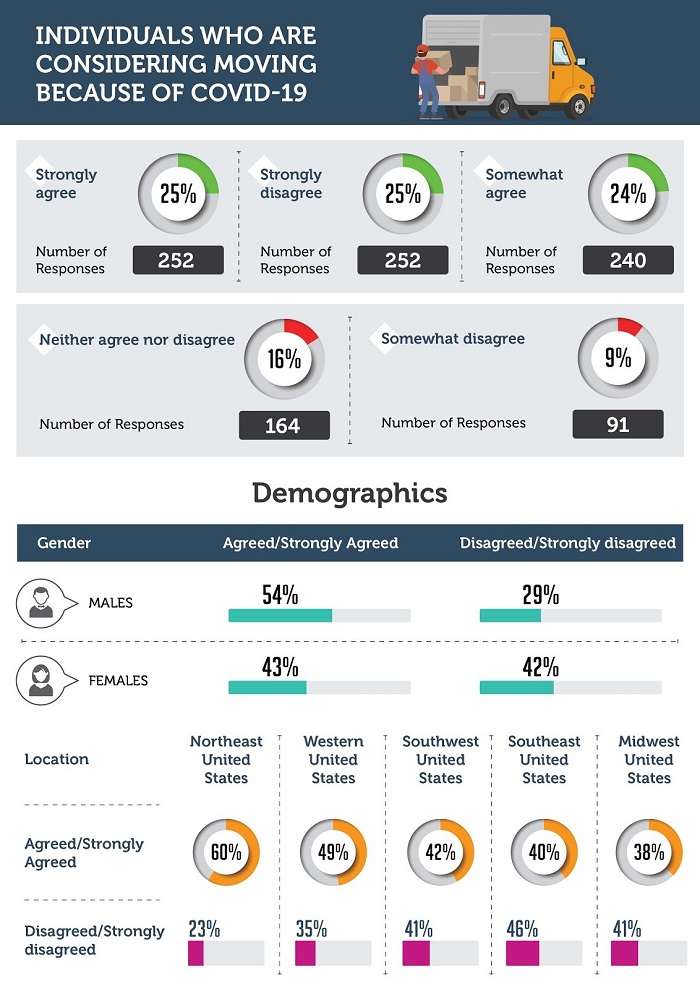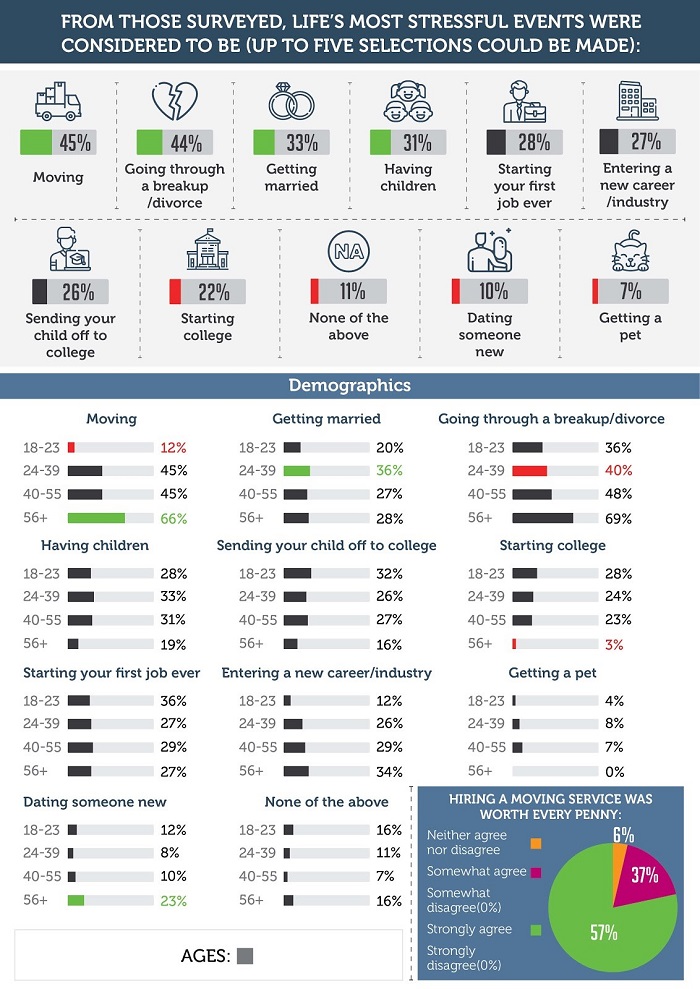How COVID-19 Has Impacted Moves in America
COVID-19 has greatly impacted the way Americans live their lives. Both short and long term decisions are made with the pandemic in mind in today’s world. When looking specifically at the housing industry, mortgage rates have dropped significantly. Although home sales suffered in the spring, by summer of 2020 we saw them rebound again.
However, even though mortgage rates have decreased, the number of homes for sale compared to this time last year has decreased. At the same time, the number of homeowners refinancing their homes have increased. The ever growing concern for job security may also impact people’s decisions regarding when and where to make such a large purchase. Even with the lower mortgage rates, the Federal National Mortgage Association predicts that 15% fewer homes will be sold this spring than last spring, specifically due to COVID-19. And yet in many cities in the United States, people are moving in historical numbers! So it is clear that COVID-19 has affected people throughout America differently - this article will touch on some of the factors behind that impact and what it means for the moving industry moving forward.
COVID-19 and how often people move.
Has the SARS-CoV-2 outbreak impacted how often people are moving? With the widespread lockdowns and corresponding shelter in place mandates, it would be easy to assume moving has been all but nonexistent during 2020.
Intriguingly, this has not been the case. Moving has been impacted, as have most major industries, but not to the extent that might be expected. In fact, in some areas such as large cities, moving has rapidly increased in 2020 compared to 2019. The graphic below offers a visual comparison of individuals moving out of cities in the last two years.

With millions of more Americans now working remotely, people are beginning to realize they can work from almost anywhere. What has been occurring, slowly yet surely, is a steady drip of individuals and families leaving their cramped, urban accommodations for nearby suburban or even rural living spaces.
This coincides with reports that more people are choosing to escape lockdown quarters by getting outdoors locally to explore. There is an argument that people are beginning to seek out nearby greener pastures in a very real and tangible way. However, some such moves - most especially in hard-hit cities like New York City and San Francisco - may also prove to be temporary.
In other cases, people have been moving from one urban area to another urban area, often one just as densely populated as the one being left behind.
Many single adults living independently reported choosing to leave New York City and surrounding areas in favor of moving home to be with family during lockdown. For example, where pandemic-related school closures left college students temporarily homeless, many may have moved back home with family to ride out the lockdown. In many larger cities, COVID-19 seems to spread more rapidly, which also plays a role in people leaving to be more “on their own” in the country, away from the masses.
Interestingly, statistics show that people are sharply divided in terms of future moving plans. For example, a full 25 percent of a recent survey stated that pandemic concerns may prompt a future move. Yet a full 25 percent also report that they do not anticipate moving in the near future for pandemic-related reasons. The following graphic dives into detail regarding people’s opinion on moving based on the pandemic.

COVID and Why People Move.
An estimated 22 percent of people in the U.S. have moved in the last six months. One-third of these survey respondents stated that their move was prompted by a need to relocate to a safer area.
Those moving also cited the following reasons for choosing to live elsewhere:
- Seeking a less densely crowded area.
- Moving home out of a need to care for an elderly loved one.
- Better work prospects to replace lost income.
- Access to safer and less crowded transportation options.
Even while some statistics indicate COVID has not been a major trigger for how often, where or why people move, the respected Pew Research Center recently released data contradicting these moving COVID claims.
Of the 20 percent of survey respondents who reported moving COVID plans, these are the top five reasons:
- 35 percent of moves were initiated by the need for more indoor space.
- 34 percent of moves occurred because they needed a new building.
- 31 percent of moves were prompted by a need or desire for more outdoor space.
- 23 percent of moves were caused by the need to find more affordable housing.
- 23 percent of moves took place to bring families back together during lockdown.
Space is clearly a pressing concern prompting many moves over the last year. With the sudden surge in remote workers, many families have discovered their living space simply couldn't effectively accommodate two or more adults living and working from home.
Perhaps this is also why the cohort is reporting the strongest potential to make another COVID-related move in the near future is between the ages of 24 and 55 - prime workforce years.
COVID-19’s Impact on the Moving Industry in 2020
Up until now, we have focused on the impact COVID has had on how often, where and why people are moving (or are choosing not to move). But what about the moving industry itself? Have moving professionals and companies experienced the type of economic impact that has rippled through the travel industry?
Not surprisingly, movers and shakers in the moving industry are genuinely worried about the near future economic health of the industry and their business. From a risk management perspective, this makes perfect sense, especially when bolstered by data showing that 74 percent of moving industry professionals have witnessed some level of downsizing during the last 12 months. 72 percent of survey respondents affirmed a near-past business slowdown attributed to the pandemic and subsequent lockdown orders.
However, as the data previously cited here showcases, moves are still taking place. Sometimes, these moves are prompted by the very same sort of downsizing that is causing economic concern in the moving industry.
However, the underlying impetus for the economic downturn itself is different this time around. Never before has the United States or the global economy experienced a downturn on this scale due to a seemingly unstoppable virus. The pandemic seems set to change our way of life - potentially forever. This means all the data available to us for study and prediction gives us only a baseline guesstimate at best for what could happen in the months and years ahead.
The rise of the remote workforce will likely have its own impact on the moving industry and it is one we are not yet well-equipped to predict. As a faint foreshadowing of brighter days to come (pandemic notwithstanding), 42 percent of Real Trends survey respondents stated that they did not intend to self-move ever again, even though 91 percent of these stated they felt capable and prepared to move again.
This statistics suggests that professional moving services will remain very much in demand for near-future moves and that demand may even increase due to COVID.
Facts about Moving for COVID or Non-COVID Reasons
These statistics represent general data about how people plan and prepare for an upcoming move, whether that move may be related to COVID or made for other reasons.
Choosing the right moving service is important.On average, nearly three-quarters (72 percent) of survey respondents said they took up to six months prior to their move date to choose a moving service!
Just 18 percent of respondents stated they took only a few weeks to one month prior to their move date to choose a moving service.
Older adults report moving as a higher stress life event.Among adults aged 55 years or younger, moving was rated as one of the "most stressful" life events by 45 percent of survey respondents. The numbers, as high as they are, go up as age increases. Among adults aged 56 years or older, moving was rated as one of the "most stressful" life events by 66 percent of survey respondents.
In both cases, moving outranked every other option in terms of the stress it causes.

How to Move Safely During COVID-19
Many Americans are unsure about the safety of moving during COVID. However, statistics do reveal that many Americans continue to make and fulfill moving plans as best they can around outbreaks and lockdown requirements.
As data in the previous section here outlines, moving is always going to be a stressful event even under ideal circumstances. It is only natural that people are reporting heightened stress when moving during the pandemic.
But this is not stopping people from moving. Rather, it is clear that what is occurring is a slow but steady shift in moving habits, moving reasons and moving frequency. Whether this shift will abate or become the new normal in the moving industry is yet to be revealed.
In the meantime, the reigning urgent order of the day is to identify best practices for the safest possible move during COVID
The continuing importance of social distancing.
Even as COVID vaccines slowly become available, social distancing is quite likely to remain of paramount importance in the new year, along with hand washing and mask wearing. This is especially the case given that not every person will be able to take the vaccine due to other complicating health conditions.
It will be vitally important for every person involved in a given move to take maximum personal protective measures to remain virus-free.
Each state and municipality sets its own COVID-related regulations and requirements.
For those wishing to make a regional or inter-state move, it will be important to stay up to date on COVID news at their destination.
While undesirable, it is likely that moves may need to be delayed or rescheduled should an outbreak of COVID occur unexpectedly at the destination.
The timing of each move will be very important for the health of all involved.
While many Americans have reported moving due to a desire or need to care for a loved one or be closer to family during lockdown, these same motivations may drive a need to delay a move.
Where someone may be at higher risk for COVID or local hospitals are already overwhelmed with COVID cases, it may be smarter to delay moving until the situation is safer. This is especially the case when factoring in mandatory quarantines of 14 days or more between moves.
It is also important to consider whether available public transportation options (bus, train, taxi, ride share, plane) may put anyone in the moving party at especial risk of contracting COVID.
Moving services may or may not be considered an essential service.
Each state or municipality decides what is considered an essential service in that area. The reason for your move may or may not impact the rules and regulations in effect in your local area and at your destination.
For this and other reasons, it is ideal to have somewhat flexible moving dates if at all possible.
Moving plans may be impacted by COVID in various unanticipated ways.
In most years, at least up to 10 percent of the population will move during the year - excluding 2019 which saw only 9.8% of the population move. Some of these will be moving for the first time ever. Even those who are experienced at moving may find their typical routines are greatly disrupted due to COVID.
From where to eat along the route to how many movers are available to help with packing and unpacking, it is important to have alternate plans if these types of situations crop up. Even if things are relatively calm at the start of a move, there is always the possibility that disruptions may occur mid-move or at your destination.
When these types of events occur, this may also cause longer-than-usual wait times for customer service at the moving company as many moves-in-progress need to be re-routed at once.

New Sanitation and Safety Procedures Implemented by the Moving Industry
Any moving company you choose to work with should take the threat of COVID very seriously. All pertinent safety measures should be in place and on full display before, during and after your move. Many companies have online surveys that allow you to share what and when you intend to move, to give the moving company a better idea of how to work around you. This can be particularly helpful during COVID, as it allows the movers to see where they are allowed to enter and exit your home and lets them work around your space and schedule to ensure proper social distancing measures.
Look for the following safety measures when selecting your moving service:
- Trucks and moving equipment disinfected before and after each use.
- Moving professionals masked, gloved and equipped with disinfectant and all available PPE (personal protective equipment) including booties for everyone's safety.
- Emphasis on adequate airflow and frequent hand washing and use of disinfectant wipes during the move.
- Moving company monitors the health of their workers to ensure no one works sick.
- No-contact estimates, moves and packing/unpacking services are not "by request" but the only option.
- Willingness to familiarize themselves with and comply with all COVID protocols at your destination.
- Add-on services include post-move COVID clean-up for increased safety.
COVID has and will continue to have a major impact on how often, where, when and how people move in the U.S. What is clear, however, is that the moving industry is making every effort to accommodate customer safety requests and special needs to provide safe and timely moving services on demand.

